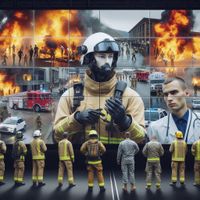When your life is at stake, optimized and comprehensive training, along with the development of holistic 360-degree approaches, is absolutely essential.
The year 2025 marks a time of rapid change. Fire brigades, police forces, security agencies, the military and society as a whole face unprecedented challenges that extend far beyond natural disasters. Political, economic and social crises demand thorough preparation, encompassing both risk assessment and damage mitigation. History has taught us that risks cannot be entirely avoided. Instead, we must learn to live with these diverse threats and prepare for them collectively as a united community.
This requires not only modern technologies and interdisciplinary collaboration but, above all, close community involvement. Only through a profound understanding of the most diverse dangers and the development of methodical 360-degree plans can we begin to truly address the unpredictable challenges of the future.
Amidst the political and economic crises reshaping our global order, fire brigades, police forces, disaster relief teams, crisis managers, security personnel (particularly in critical infrastructure), civil protection organizations, the military, paramedics and first responders play a crucial role.
Optimal preparation for unforeseen events is essential, as threats from diverse areas — whether political, health-related, familial, economic, cultural, natural, technological, legal, religious or in the fields of education and knowledge — impact our daily lives.
"A crisis is an opportunity riding on a dangerous wind" – 危機是騎著危險風的機會 (Chinese proverb, often attributed to John F. Kennedy). It's a reminder to seek opportunity even in turbulent times.
What we need in the future to be well-prepared for emergencies
Firefighters today play an outstanding and central role — not only as rescuers in acute emergencies but also as indispensable actors in an increasingly complex security environment. The challenges they face are diverse: from extreme weather events such as forest fires and floods, to technological risks like industrial accidents or hazardous material transportation and even potential threats from terrorism or other crisis scenarios. Firefighters are often the first responders on site and are confronted with situations that demand quick, well-informed and often life-saving decisions.
Scenario Training in AR and Real Life: An Important Yet Often Underrated Balance Between High-Tech Innovation and Human Care
Optimized scenario training: Advanced AR training methods (Augmented Reality) could be a valuable addition to hands-on training, as they offer new possibilities for performance enhancement and analysis. Striking the optimal balance between both methods is crucial to achieving the best possible outcomes in terms of training and resilience. By combining both approaches, we could significantly improve not only responsiveness but also adaptability and decision-making in real extreme situations. This would be an essential contribution to the safety and resilience of emergency personnel and society as a whole.
Here is an overview of the scenarios
- Scenario Training in AR and Real Life
- Key Groups for Training
- Examples of (Possible) Training Scenarios
- Training in Crowd Management with Augmented Reality (AR) – Simulation of varying crowd sizes
- Practice of Evacuation Strategies
- Advantages of AR-Supported Crowd Management
- Overcoming Technological Challenges with AR
- Examples of Modern Building Materials' Behavior During Fires
- Identifying Potential Gaps
- Presentation of Personas to Highlight Challenges of Missing PGx
- PGx Considerations: Enrichment and indispensable necessity for all who work (also) in critical areas
- Emergency Medications & DDIs / COMT and Neurotransmitters / GSTs Deletion – Impact on firefighters/emergency responders
- Improved Resilience and Health
- Scenario Description: Virtual environment simulating a burning building with narrow corridors and obstacles. An isolated firefighter has already lost contact with his team, has no hose line, no tools, and possibly even no communication device, while the fire rages around him and the danger of building collapse exists. The firefighter faces a situation where retreating to save his own life takes precedence over conducting an offensive firefighting operation.
- Hazardous Materials in Training with Augmented Reality (AR)
- Integration of Cortisol Levels into Training Scenarios
- Firefighters with Orthostatic Problems
- Firefighters with CFS (Chronic Fatigue Syndrome)
- Exercises
- Operational Context – Focus on Strengths
- Realistic Physics Engines in AR Training Scenarios (Behavior of Tools and Materials)
- Myopia/Short-Sightedness: Adjustments and considerations ensuring firefighters with short-sightedness can train safely and effectively.
- Mindfulness Meditation: A mental reset button for firefighters, police ...
This contribution was written by Birgit Bortoluzzi, the creative founder of the “University of Hope” – an independent knowledge platform with a mission: to make resilience, education, and compassion visible and audible in a complex world.


